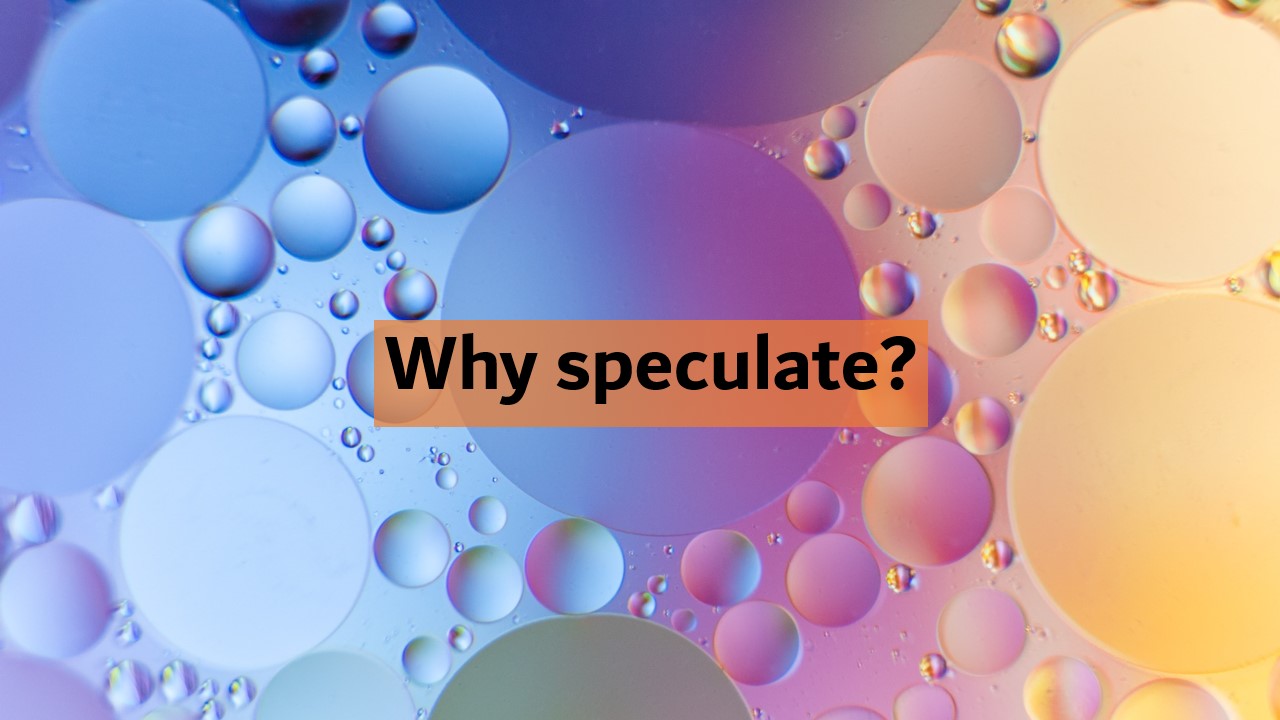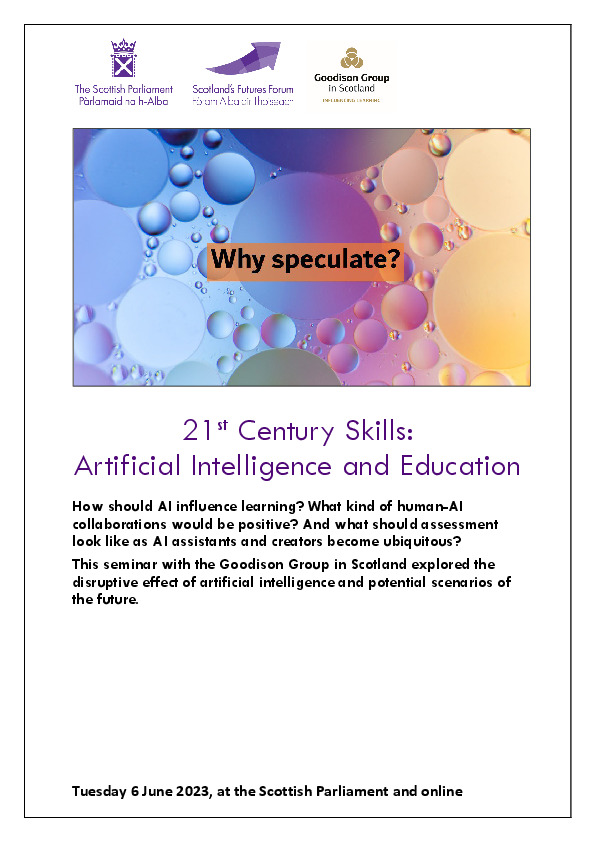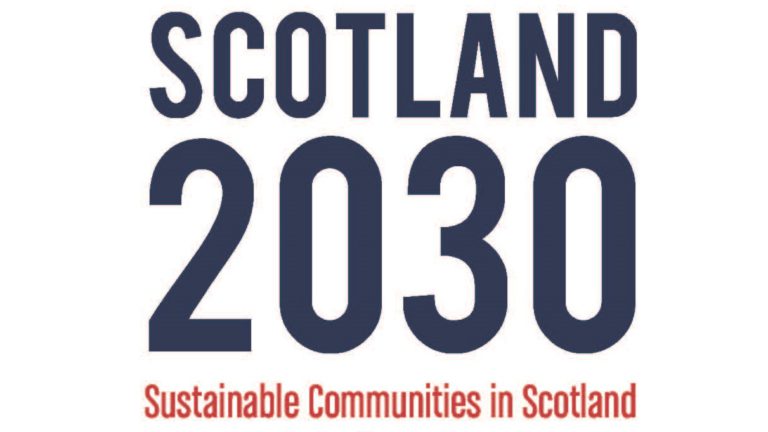AI and Education with the Goodison Group in Scotland
Tuesday 6 June 2023, at the Scottish Parliament and online
This event brought together leading figures from education to discuss the disruptive effect of artificial intelligence. How should AI influence learning? What kind of human-AI collaborations would be positive? And what should assessment look like as AI assistants and creators become ubiquitous?
Featuring an expert contribution by Dr Jen Ross from the University of Edinburgh, this forum debate explored a key challenge and opportunity for education and learning in the coming years.
This is the first in a series on Learning through Life in the 21st Century, which the Goodison Group in Scotland is running with support from the Futures Forum.
Key messages
Artificial Intelligence [AI] has the potential to assist learners and teachers by responding effectively to individual needs. It could help make content accessible and relevant to learners, especially those with complex needs, and enable learners to explore subjects more deeply.
While AI offers personalized learning, there is a risk of creating a narrow bubble around learners, limiting exposure to diverse perspectives and hindering personal growth.
AI in education raises ethical and moral concerns, such as the impact on human interaction, the automation of previously human systems, and determining the boundaries of legitimate learning support and cheating.
The expansion of AI technology might challenge the purpose of schools, shifting the focus from instruction to building capacities and shared values among a diverse community of learners.
AI could exacerbate inequality if access to learning resources and technology is limited, but it could also provide equal opportunities by simulating diverse school environments and enabling remote access to quality education.
The impact of AI extends beyond education, requiring consideration of its implications on society, power structures, sustainability, and the overall purpose of education.
Background blogs
As background to this event, two Futures Forum blogs have been produced on the potential effect of AI on education and skills more generally:
Introduction
As a starting point in considering how education and learning throughout life can be radically reformed for the 21st century, this seminar looked at artificial intelligence and education. Should we see AI as an opportunity or a threat? How should artificial intelligence influence learning and education?
The seminar featured a presentation by Dr Jen Ross, co-director of the Centre for Research in Digital Education at the University of Edinburgh, an open Q&A session, and workshop groups to explore a scenario of the future.
This report, produced by Scotland’s Futures Forum and the Goodison Group in Scotland, summarises the presentation and key messages to come out from the Q&A and workshop groups. It also includes details of the scenario of the future and workshop group exercise. It may not represent the views of everyone present at the event.
Presentation: Exploring Futures for Artificial Intelligence in Education
Dr Jen Ross, Co-director of the Centre for Research in Digital Education at the University of Edinburgh
Jen started by framing the challenge: How can we use the current uncertainty around AI and education in a creative way to articulate our values and help us chart a path for where we might want to go?
Jen indicated that it is important to define what we mean by artificial intelligence, and she started by highlighting a couple of useful definitions:
- “Technologies used to allow computers to perform tasks that would otherwise require human intelligence, such as visual perception, speech recognition, and language translation.” (“Scotland’s Artificial Intelligence Strategy”, 2021).
- “Machines that can learn from their own experience, adapt to their contexts and uses, improve their own functioning, craft their own rules, construct new algorithms, make predictions, and carry out automated tasks without requiring control or oversight by human operatives.” (Williamson and Eynon, 2020)
In addition, Jen noted that AI can also be defined as “whatever hasn’t been done yet” (Woolf, 2015). As she described, AI developments in education have not emerged fully formed from nowhere; work has been going on since the 1950s, but as soon as something becomes useful and integrated into existing software or practices, we stop thinking about it as artificial intelligence.
Jen argued that keeping in mind this historical context is important, as it allows us not to be intimidated by what we see coming down the pipeline.
AI in education
On the use of AI in education, Jen said that it consists of not just the “flashy stuff” such as automated tutors, but the mundane changes that are happening at the back end of educational systems. She emphasised that it was useful to understand the bigger picture, highlighting a key question: how do different AI applications define and understand learning?
There is AI work going on that maps to various understandings of learning, for example as progress, mastery, creativity or connection, where learning is:
- made visible and predictable through big data, tracking and monitoring.
- improved with intelligent, personalised, just-in-time input.
- supported with tools and services that the learner calls on.
- collaboratively enacted through a combination of humans and technologies.
AI and the ‘teacher function’
Jen stated, in discussing how AI can help teachers or improve education, we are often talking about changing the nature of the relationship between teachers and students or what the teacher role involves. It is therefore useful to talk about the “teacher function”.
Jen set out some different models and approaches for thinking about how AI and automation might interact and intersect with teachers and with schools and educational institutions:
- human teachers focus on personal, expert, complex tasks and interactions with students, while more routine, administrative and other tasks are automated.
- human teachers focus on delivering content, while automated, intelligent systems ensure students receive this content in suitable ways and test their attainment.
- intelligent tutoring systems, automated essay grading, automated creation of personalised pathways are combined as the teacher function with little human input.
- human and non-human nodes in a network generate knowledge across time, space and between contexts.
How AI can work
As Jen outlined, when we are confronted with a new service or a new product, it may not be immediately clear what vision of learning it seeks to promote, or what kind of impact it is predicted to have on teachers.
She highlighted an influential report from 2016 by Rose Luckin and colleagues at UCLA, which attempted to map out what an artificial intelligence education system could look like.
This map positions pedagogy – the way we teach – along with subject expertise and knowledge of individual learners as inputs into an AI tutoring system. The system then presents content that is tailored for individual learners, who interact with and respond to it. The system captures data from these interactions, which it then uses to improve how it works for the learner.
Big business
Jen stressed that artificial intelligence in education is big business right now, and that the 2021 estimate that the global market for AI products for education would expand from $1.1 billion in 2019 to $25.7 billion by 2030 might now be an underestimate. She highlighted the need, however, to be careful and sceptical about the claims that are being made for these technologies.
A report from 2021 by Keri Facer and Neil Selwyn gave two examples. When the Century AI platform was adopted in 700 Belgian schools in 2019, there were claims that it could boost learning levels by 30% and reduce weekly teacher work by 6 hours. In China in 2021, Squirrel AI claimed that its intelligent adaptive learning system could boost student learning levels in poor rural communities beyond the average performance of more advantaged groups.
Jen pointed to Robbie Scarff’s blog for the Futures Forum in which he notes that, although proponents argue that AI can accurately determine people’s emotional states, “an academic review in the journal Psychological Science in the Public Interest has argued strongly that it simply cannot do this”. Equally, while there is a lot of publicity when these programmes are launched, Jen pointed out that it is harder to get information about how effective they have been.
AI around education
As Jen identified, the wider context of AI outside formal education involves the development of generative AI tools such as ChatGPT. These tools, services and processes were not created with education in mind, but are being adopted by teachers, students and school systems.
While some tools might be influenced by educational principles, others are not. Jen emphasised that development of these types of AI is happening independent of what we may or may not want to do with it in classrooms and other educational settings.
Jen raised another key question: are we currently on the cusp of some big shifts more broadly in how people write, create and consolidate knowledge?If so, what does that mean for education? Again pointing to the blog by Robbie Scarff for the Futures Forum, Jen noted that services like Cram 101 might be able to synthesize textbooks and to study guides, but being able to discern what is important from what is not important is a really important skill that could be lost.
Jen stressed that, while we need to be realistic about the fact that technology might move beyond our control, it is vital to consider the potential unexpected effects of these technologies.
AI in society
Jen linked this to the topic of broader controversies around artificial intelligence and its role in society. Examples include the question of whether the automation of workplaces is putting people out of jobs; algorithmic forms of bias; and the power that technology corporations may have to shape our social and educational worlds as these technologies gain ground.
Nevertheless, Jen argued that the prospects with AI are “not all doom and gloom”. She asserted that the education community, and humans more broadly, are doing great work to try to articulate our values as they could or should apply to AI. She described that as a key response to inform our work with artificial intelligence in education and more widely.
As Jen noted, Scotland’s AI strategy builds on Scotland’s national performance framework, which states that our society treats people with kindness, dignity and compassion, respects the rule of law in an open and transparent way.
Jen flagged up another important question regarding values: how do we advance our educational values and facilitate better educational experiences without adding to teachers’ workloads or undermining their work (Gallagher and Brienes 2021)? She said that striking a balance in that respect is “tricky but important”.
Pragmatic and hopeful
On the subject of values, Jen highlighted the importance of the five Organisation for Economic Co-operation and Development principles on artificial intelligence:
- Inclusive growth, sustainable development and wellbeing to benefit people and the planet
- Respect the rule of law, human rights, democratic values and diversity
- Transparency and responsible disclosure
- Systems need to function in a robust, secure and safe way
- Organisations and individuals who develop and deploy AI systems need to be able to be held accountable for their proper functioning.
She argued that if these principles were enacted, they would help to address some of the controversies and issues and could be applied to the sphere of education specifically.
Jen also referred to the UNESCO “Chat GPT and Artificial Intelligence in higher education: quick start guide” on how generative AI can be incorporated in, and used to augment, teaching and learning in higher education. She noted that the report balances a pragmatic and somewhat hopeful approach with a clear vision of the policy implications.
Alternatives to prediction
Turning towards the workshop activity, Jen emphasised the importance of speculation, stressing that it is not about trying to predict or model the future, but about trying to work with uncertainty in a way that is creative and generative.
As she stated, we need to think differently about the ways that these technologies may come into our educational settings and how we manage, respond to or work with them. She quoted a New Yorker article by Ted Chiang, which highlighted that:
“The tendency to think of A.I. as a magical problem solver is indicative of a desire to avoid the hard work that building a better world requires.”
She noted that predictions can shape education policy, practice and theory because they make certain futures come to seem inevitable and thereby produce realities. She highlighted the view that, while anticipatory regimes try to predict the future in order to close down and eliminate risks, this can prevent us from taking a more expansive approach to “collective action and forward dreaming” (Amsler and Facer, 2017).
As a more useful approach, she suggested that we need alternatives to prediction to try to keep things more open, using the future as a space of uncertainty and creativity. In this way, she argued, we can engage with complexity in educational futures, highlighting the view that speculative approaches “can loosen, even just a bit, reality’s grip on our imagination” (Dunne and Raby, 2013).
Rather than seeking to create one overarching idea of the future, Jen asserted that we need to put many different ideas into play in order to be able to discuss them, and that we have to make space for conversations about the future.
As an example of speculation, Jen referred to the the Higher Education Futures project at the Centre for Research in Digital Education, University of Edinburgh. Of the eight possible scenarios for the future of higher education that were produced in the project, three referred directly to artificial intelligence:
- The “AI academy”, where machine learning and AI become the infrastructure, surveillance is everywhere and everything is delivered to you, raises the question of what we are going to do in these universities.
- The “Return to the ivory tower” is a dystopian scenario in which widening participation policies have failed because automation and AI have decimated semi-skilled work. Academic study is now only for a small number who are likely to move into elite roles, and the gated physical campus is once again the locus of university life.
- In “The university of ennui”, automation has taken all the jobs, and paid work is no longer the defining activity of adult humans so everyone has time for lifelong higher education; however, humans are struggling to understand what they are for.
Forum reflections: key messages
Following Jen’s presentation, participants considered the issues in both an open Q&A and small group workshops. Full information on the workshops is provided at the end of this report.
The following key messages and questions emerged from the discussions under three main headings:
- Using AI in education
- The effect of AI on education
- The role of AI in society
Using AI in education
AI has the potential to help learners and teachers.
AI technology could be used to augment teaching ability, enabling teachers to respond more effectively to a learner’s needs.
AI might be particularly useful in translating content into age and stage appropriate language and making things culturally relevant to a learner. Learners with complex needs may have systems to support their engagement in learning that adjust more quickly than humans can.
The technology might also help learners to embrace a particular subject or challenge in more depth and breadth, changing the way in which expert knowledge is structured in education. This could also lead to a more interdisciplinary approach.
The notion of “flipped learning” could be developed further using AI, as the education system reconciles the instructional role of the teacher with the availability of instructional learning through AI and the need to reimagine the school as a community of learners.
But AI will not automatically be educational
The idea of education as a public good is true only if it is equally accessible to everyone. A lot of current AI developments in education are happening in the for-profit sphere, and there is a risk that big tech companies and commercial interests will be more interested in making money than the promotion of democratic education.
When applying AI in an educational setting, we have to be clear about how it works – who controls it and what information have they used to develop it? For example, is a learner’s personalised AI based on what they have read, listened to or searched for? Those questions will become ever more important given the increasing prevalence of AI assistants.
A transparent system will help education leaders decide what any AI system is qualified to do. This takes us back to the OECD principles of AI ethics and the questions that follow, including in the Futures Forum’s AI toolkit: How was the system designed? Who do we talk to if there is a problem?
Personalised learning can be good, individualised learning is more dangerous
AI offers the opportunity to tailor learning material and experiences to individual learners. While there are undoubted benefits in this, there is a risk that a dependence on AI systems might create a very small bubble around a learner so that, rather than opening up their horizons, it inadvertently makes their world contract.
This is not an easy balance to strike. We value the fact that people are different and need different things from their learning, but where does that slip into an education system that fails to expose people to difference or broaden horizons.
This could be described as the difference between personalisation—where something becomes more tailored to the individual—and individualisation, where education becomes an atomised relationship between a single student and a technology. It is vital that learners understand the role of AI, its capabilities and its limitations.
AI is part of the solution, but it is not the whole solution.
It is clear that there are opportunities with AI. Chatbots can be used to provide information and even pastoral support to learners, but AI systems can never replace human interaction completely. As experienced during the Covid-19 pandemic, remote learning through technology can be positive, but young people still miss the school community. As was noted, “kids need to be in school, for so many reasons beyond just learning.”
In judging what part of the solution AI will form, one key question identified was: What are the education policy levers that matter in the future of AI in learning?
The effect of AI on education
AI will enable us – and perhaps force us – to consider what schools are for
As AI technology expands, schools can be bypassed as the instructional side of learning can take place anywhere. This presents a radical change to instruction as the defining mission of the school, with schools focused more on building capacities and values.
Many educators already see themselves more as facilitators rather than instructors, so this may continue a trend already developing. However, schools remain a crucial focus of community life and an important factor in making people want to learn, and learn together. Young people get huge opportunities for social engagement and enrichment from school, which will continue to be a part of the purpose of schools.
There have also been many calls for more flexibility within the education system, in particular for those with additional support needs. Many autistic learners thrived during lockdown without the pressures of school, while AI might enable young carers to learn at a time and place that suits their caring needs. The development and adoption of this technology will help us explore these issues more openly.
AI will bring up ethical and moral issues
As well as the practical questions of how effective AI systems are, there will be questions about how much we should replace human interaction between a learner and other learners or the teacher.
Given concerns about behaviour in schools, it remains important to ensure learners feel connected with their fellow learners and broader community. As with the direction question of personalised learning, those deploying AI will have to decide how far they go in automating systems that were previously human – not just in the classroom but in dinner halls, school offices and elsewhere on a school’s campus.
There are also wider questions, particularly important for education, about what is legitimate learning support from generative AI systems and where do we draw the line on original work. In effect, what is cheating?
AI in society
AI could increase inequality in society
Equity should be a central consideration. If schools become unnecessary because young people can access learning elsewhere, there is a risk that not all young people will benefit if neither they nor their parents have the knowledge or the ability to do so.
This was seen during the pandemic when some pupils lacked access to resources or connectivity and suffered as a result. Some young people already experience difficulties in finding good spaces in which to learn or access technology. Could schools become broader learning spaces that are used in different ways, as libraries were historically? We need to start thinking creatively in order to avoid a “digital divide”.
Or, more positively, AI could help prevent inequality
The ability of AI to simulate a diverse school environment means that everyone could have the opportunity to access a good ‘school’ remotely. This could mean that choice of school would not depend on geographical location, but enable a real diversity of offerings in education.
Likewise, AI could free up schools and society more generally to devote more time to community building, hands-on skills and spending time outside. That depends on the incentives and restrictions around the use of AI generally, plus wider social and political questions. Many of these decisions will be made separately from technical decisions on AI, but it is not clear where they can or will be made: locally, nationally or globally?
This isn’t just a question for the education system
We need to understand the impact that AI can have across the whole field, and across disciplines and practices. In a competitive world, will the speed and efficiency of AI provide an advantage? How do power structures affect what is possible?
In the context of a climate and biodiversity emergency, will AI machines be sustainable? What energy and resource demands will they make?
The society around us, and not just education, will change, and AI is likely to be a large part of that. It is important to embrace it carefully.
This requires clarity over the purpose of education, which will help us decide how AI could be best incorporated alongside other educational resources to provide a good education for all learners.
Creative Workshop: A learning and assessment future
In the workshop session, small groups considered a potential future scenario described by Jen and imagined possible consequences for the education system in Scotland from one of seven perspectives.
The scenario was written to focus on a key idea: what assessing and measuring learning might look like if AI assistants and creators become ubiquitous.
It is intended not to be a prediction, but instead to open up possible lines of thought that challenge some standard reactions we are seeing in 2023, where many institutions, educators and edtech companies are looking for ways to identify and prevent student use of generative content.
This imagined future is instead one in which generative content is everywhere, and fully integrated into daily life for most people in Scotland (though perhaps not completely equally). Workshop participants were asked to consider what this world might feel like, and be like, for people experiencing it.
A scenario of the future by Dr Jen Ross
Generative AI technologies have become increasingly powerful. They can access real-time information via the web and filter content in sophisticated ways. They are also able to learn the style, interests and perspectives of individuals.
The launch of personalised AI assistants emerged in a number of settings:
- Workplaces, in the form of email-focused AIs that would read, digest, summarise, and even respond to the deluge of communications that office workers were receiving, all tailored to the company, the role and the person they were trained to assist.
- Personal AI assistants designed by start-ups in response to widespread corporate use of advanced chatbots for customer service.
- Automated writing support and translation systems, which ushered in a new age of flawless communications.
Before long, these separate systems began to converge. The hottest tech companies were holding out the promise of the perfect personal assistant: it was always on, it knew everything, and it could manage your digital world in almost limitless ways.
From responding to friends’ posts on social media, to booking travel and making appointments, to producing a perfectly tailored presentation for a new client, to advising on an ongoing conflict in the neighbourhood, these AIs have become more and more integrated into daily life.
For those who can afford the high-end, verified versions, they can also help seamlessly navigate an increasingly complex landscape of financial and civic interactions.
In Scotland, as in other countries that enshrined the OECD principles for AI into law, things have moved a little more slowly. Many innovative and ethical companies, think tanks and social enterprises are drawn to working in these countries, but ensuring responsible and trustworthy applications of these technologies takes time.
However, the benefits of this slower pace meant that some of the more significant failures, data breaches and social impacts seen elsewhere affected citizens less, and there is therefore now more willingness to trust and experiment at personal, community and civic levels.
Now, because of the data these systems gather, the digital version of each individual has become more and more rich, detailed and convincing. Their activities are transparent, if you have time to monitor their outputs.
Sometimes people forget to listen to their daily briefings or unexpectedly run into someone, and this leads to awkward real-life conversations amongst family, friends, and co-workers who realise, too late, that the AI has been communicating on their behalf. Filters and apps to manage human-AI relationships are regularly launched and updated. Frequent decisions are required about what to do yourself and what to delegate.
One of the most controversial developments in this technology has been in the recent introduction of powerful AI assistants for very young children. Children’s lives have long been tracked and quantified, and educational toys and technologies were already sophisticated enough to be considered intelligent in the way they could interact with children in personalised ways.
But, with the launch of the biggest AI company’s “Little Life” service, questions that were already being asked have become more urgent. Do these technologies smooth over the textures of life in damaging ways? What is the future for a generation of children who have such assistance at their side every moment of the day?
And this doesn’t even begin to describe what has been going on in formal education…
Individual perspectives:
- A P5 teacher in a large, popular primary school. The school prides itself on its data arts curriculum.
- A 14-year-old who hates school and prefers to focus on their hobby of making and selling custom-made skateboards.
- A parent of two children, aged two and five. The older child had significant health issues in the first few years of their life and didn’t get their “Little Life” account until this year, while the younger child already has one.
- A headteacher in an independent secondary school where most students board at least part of the school year. The school is a popular choice for parents from around the world who want their children to receive intensive, personal tutoring.
- A university lecturer in biology, teaching large undergraduate classes as well as supervising PhD students and running a research lab.
- A 45-year-old university student with severe dyslexia. They are studying part time for a psychology degree because they want to change careers to become an educational psychologist.
- A 9-year-old who enjoys writing stories and poems. Their family immigrated to Scotland two years ago and their English is still developing.
Questions to consider:
- What AI technologies and practices do you think are significant for this person and their relationship to education?
- What are the exciting and positive aspects of this educational future from this perspective?
- What are the concerns and risks?
What questions does your group have?
Useful links
International resources
- Organisation for Economic Co-operation and Development principles on artificial intelligence
- Chat GPT and Artificial Intelligence in higher education: quick start guide by UNESCO
Scottish resources
- Exploring Children’s Rights & AI – Children’s Parliament, the Alan Turing Institute and Scottish AI Alliance project
- Scrutinising the Use of Artificial Intelligence: A Toolkit | Scotland’s Futures Forum
- Scottish AI Alliance – Delivering Scotland’s AI Strategy
Reflections on AI and education
- Artificial Intelligence and Education | Scotland’s Futures Forum blog
- Artificial Intelligence and Skills | Scotland’s Futures Forum blog
- Student blogs produced for the Goodison Group in Scotland
Speaker

Dr Jen Ross is a senior lecturer in Digital Education at the University of Edinburgh. She is co-director of the Centre for Research in Digital Education, and leads the new MSc in Education Futures in the Edinburgh Futures Institute. Her research interests include higher education and cultural heritage futures, online distance education, digital cultural heritage learning, Massive Open Online Courses (MOOCs), digital cultures, and online reflective practices.
In 2013-14, Jen was a Beltane Scottish Parliament Engagement Fellow at Scotland’s Futures Forum, looking at the future of MOOCs and online distance education in Scotland. Her recent book, Digital Futures for Learning (2023), explores speculative approaches to researching and teaching about the future of education.
Partners

The Goodison Group in Scotland is a charity dedicated to learning through life.








